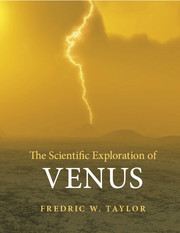The Scientific Exploration of Venus
Langue : Anglais
Auteur : Taylor Fredric W.

A leading Venus researcher explains in a friendly non-technical style what we know through our investigations of Earth's 'twin' planet.
Venus is the brightest 'star' in the night sky and it has been observed since ancient times. Often dubbed Earth's 'twin', it is the planet most similar to the Earth in size, mass and composition. There the similarity ends: Venus is shrouded by a dense carbon dioxide atmosphere, its surface is dominated by thousands of volcanoes and it lacks a protective magnetic field to shield it from energetic solar particles. So why isn't Venus more like Earth? In this book, a leading researcher of Venus addresses this question by explaining what we know through our investigations of the planet. Venus presents an intriguing case study for planetary astronomers and atmospheric scientists, especially in light of the current challenges of global warming, which supports, and potentially threatens, life on Earth. Scientifically rigorous, yet written in a friendly non-technical style, this is a broad introduction for students and astronomy and space enthusiasts.
Part I. Views of Venus, from the Beginning to the Present Day: 1. The dawn of Venus exploration; 2. Mariner and Venera; 3. Pioneer Venus and Vega: orbiters, balloons and multi-probes; 4. Images of the surface; 5. The forgotten world; 6. Earth-based astronomy delivers a breakthrough; 7. Can't stop now; 8. Europe and Japan join in: Venus Express and Akatsuki; Part II. The Motivation to Continue the Quest: 9. Origin and evolution: the solid planet; 10. Atmosphere and ocean; 11. A volcanic world; 12. The mysterious clouds; 13. Superwinds and polar vortices; 14. The climate on Venus, past, present and future; 15. Could there be life on Venus?; Part III. Plans and Visions for the Future: 16. Solar system exploration; 17. Coming soon to a planet near you: planned Venus missions; 18. Towards the horizon: advanced technology; 19. Beyond the horizon: human expeditions; Epilogue; Appendix A. Chronology of space missions to Venus; Appendix B. Data about Venus.
Fred Taylor is Halley Professor of Physics at the University of Oxford. He is a senior figure in the planetary science community, and has been involved in NASA and ESA missions to study Mars, Venus, Jupiter and Saturn. He is also a prolific author – in addition to his Mars book, he has written The Cambridge Photographic Guide to the Planets (2001) and the textbooks Elementary Climate Physics (2005) and Planetary Atmospheres (2010), and he has co-authored five other books. His lead roles in the Pioneer Venus and Venus Express missions give him a unique and authoritative perspective of this area. He is the recipient of numerous awards including thirteen NASA Achievement Awards; The Bates Medal of the European Geophysical Society, for Excellence in the Planetary Sciences; and The Arthur C. Clarke Lifetime Achievement Award.
Date de parution : 09-2014
Ouvrage de 314 p.
20.8x26 cm
Disponible chez l'éditeur (délai d'approvisionnement : 14 jours).
Prix indicatif 57,55 €
Ajouter au panierThèmes de The Scientific Exploration of Venus :
© 2024 LAVOISIER S.A.S.



